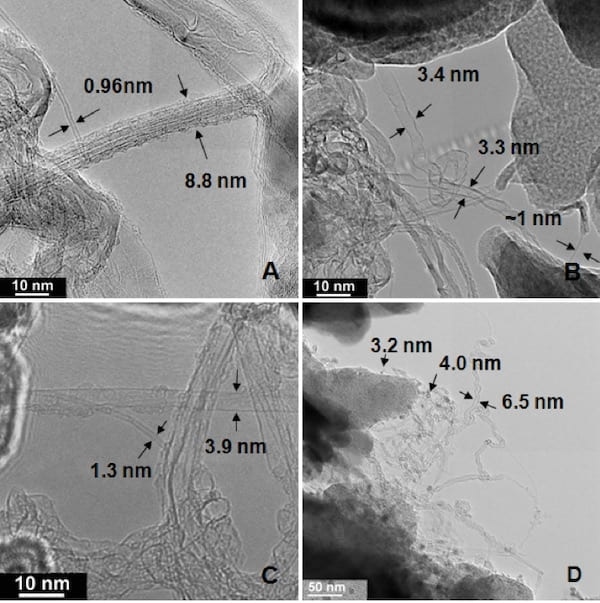Nov 29 2019
Scientists at Rice and Swansea universities have formulated a method to utilize low-cost newsprint extracted from newspapers to grow nanotubes for the industry.
 Transmission electron microscope images of raw carbon soot grown on kaolin-sized newsprint shows (a) roped single-walled carbon nanotubes, and (b) collapsed, (c) folded, and (d) twisted nanotubes. Image Credit: Bruce Brinson.
Transmission electron microscope images of raw carbon soot grown on kaolin-sized newsprint shows (a) roped single-walled carbon nanotubes, and (b) collapsed, (c) folded, and (d) twisted nanotubes. Image Credit: Bruce Brinson.
A study launched by late Rice researcher Robert Hauge and continued by research scientists Bruce Brinson and Varun Shenoy Gangoli and chemist Andrew Barron revealed a specific kind of newsprint could be treated to act as a 3D substrate for the growth of single-walled carbon nanotubes.
Stacked newsprint that incorporates kaolin clay and used as the catalyst-bearing substrate is a low-cost, very high surface-area growth medium compatible with continuous-flow production methods.
Bruce Brinson, Study Lead Author and Research Scientist, Rice University
Not all newsprint is formed equally. Only newsprint created with kaolin (china clay) sizing enabled carbon nanotube growth. Sizing is a filler added to paper to alter its color, absorption, and wear characteristics. The scientists learned that kaolin helps reduce iron to nanoscale catalyst particles that curtail the aggregation of nanotubes in the end product.
Our observation that kaolin sizing, and not calcium carbonate sizing, offers insight into how the growth catalyst—in our case, iron—is affected by the chemical nature of the substrate.
Andrew Barron, Chemist and Director of Energy Safety Research Institute (ESRI), Swansea University
One newspaper, The Rice Thresher, tried for nanotube growth was incompatible, the scientists discovered. For those that were compatible, only the parts without ink met the requirement, restricting lab studies to sections clipped from the papers’ edges.
Brinson roughly calculated that kaolin is part of 60% of the world’s paper products.
It’s whiter and brighter than most. A key to newsprint is that it is thin, cheap and light. We only need the surface; the bulk between the front and back surfaces doesn’t count for much.
Bruce Brinson, Study Lead Author and Research Scientist, Rice University
According to Brinson, the chance to prepare the substrate in bulk sets apart newsprint from conventional chemical vapor deposition substrates. He said the process has the potential to minimize the use of hazardous materials and greenhouse gases in bulk nanotube growth.
Co-authors of the paper are Rice research manager Anjli Kumar and adjunct faculty member Wade Adams, former director of Rice’s Smalley Institute for Nanoscale Science and Technology. Barron is the Sêr Cymru Chair of Low Carbon Energy and Environment and professor emeritus of chemistry and materials science and nanoengineering at Rice.
The study was supported by the Office of Naval Research.